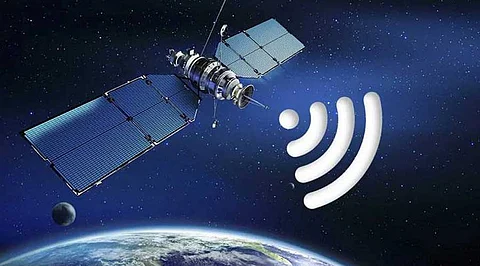

Satellite internet is a type of internet service that beams data directly from your provider to a satellite in space, and eventually to a dish at your home. In other words, it is a wireless connection that involves three satellite dishes. One is at the internet service provider's hub, second in space and the final one is attached to your property.
Additionally, you also need a modem and cables running to and from the dish to your modem. Once everything is connected, the ISP will send the internet signal to the dish in space which relays it to you. Whenever you make a request, it goes to the dish in space and to the ISP's hub. Then the completed request is sent back through space first to your dish and then to your computer.
This technology immensely helps the users who live in rural areas that lack wired internet services.
It uses a five-part relay system:
Internet-Ready Device
An internet-ready device can access the internet through the proper service, including your computer, tablet, smartphone, smart TV, gaming consoles. When you use the internet on one of the mentioned devices, it transmits data through your modem or router.
Modem/Router
A modem first translates data to move between your internet-ready device and the satellite dish. You can connect to devices such as a computer, smart TV, gaming console, or directly to your modem using an Ethernet cable.
However, those cables can be a bit messy, and you'll still require Wi-Fi capacity for devices like smartphones and tablets. That's when you need a router. It connects to the modem to enable Wi-Fi capabilities.
Some modems have a built-in router which takes less space. It can be easier to upgrade your equipment if you purchase a modem and router separately.
Many providers allow you to lease their modem/router, or you can buy the equipment on your own. Before purchasing your own, make sure it's compatible with your satellite internet provider services first.
Satellite Dish
The next step in the relay is deploying a satellite dish at home. This dish must be positioned in such a way that can beam signals to the provider's satellite in orbit and receive information back. In this case, you can rely on a local certified technician.
The imposition of a satellite dish can make satellite internet difficult for travelling RVs. Additionally, your account is set up under a specific spot beam from the satellite in space. So, the internet would be somewhat limited.
Satellite in Space
The spacecraft used for satellite internet Nearly 22,000 miles above the surface of Earth hold position over the equator. These rotate with the planet. Hence the signal relay stays consistent. It enables two-way data transmission between your dish and the provider hub, or NOC.
Viasat and HughesNet have their satellites with spot beam technology. Spot beams cover specific areas of the U.S, rather than covering the entire country. Because of spot beams, you can access your unique content, different from everyone else on the internet.
Network Operations Centre
Every time you request information from the internet, either opening Facebook or streaming a video, the data from that request is responded through the above relay. The satellite then sends the request to the NOC.
Using a broader satellite dish than the one you have at home, after receiving the request, the NOC taps into the internet backbone. In short, it gathers the information you requested and sends it back to you through the relay.
Above the process, including traversing information 22,000 miles twice occurs in fractions of a second.
As the information has to travel, you may notice more latency also known as lag than you might with DSL or cable internet. However, advances in technology have made the satellite internet today faster than it was before.
Join our WhatsApp Channel to get the latest news, exclusives and videos on WhatsApp
_____________
Disclaimer: Analytics Insight does not provide financial advice or guidance. Also note that the cryptocurrencies mentioned/listed on the website could potentially be scams, i.e. designed to induce you to invest financial resources that may be lost forever and not be recoverable once investments are made. You are responsible for conducting your own research (DYOR) before making any investments. Read more here.
